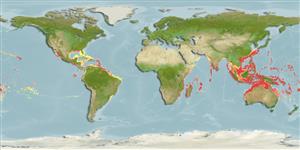Common names from other countries
Environment: milieu / climate zone / depth range / distribution range
Ekologi
Pelagis, permukaan; kisaran kedalaman 0 - 500 m (Ref. 115106). Subtropical; 30°N - 16°N, 100°W - 78°W
Cosmopolitan.
Length at first maturity / Size / Weight / umur
Maturity: Lm ? range ? - ? cm Max length : 0.8 cm BL jantan/; (Ref. 3682)
Maximum depth from Ref. 83943. This is an oceanic epiplanktonic species (Ref. 3702). Particularly found in epipelagic and mesopelagic depths (Ref. 83943). Also neritic (Ref. 116105). Chaetognaths are active carnivores, feeding mostly on copepods, crustacean larvae and other chaetognaths, and occasionally on forams and fish larvae (Ref. 81541).
Life cycle and mating behavior
Kematangan | Reproduksi, perkembang biakan | Pemijahan | telur-telur | Fecundity | Larva
Members of the phylum Chaetognatha are hermaphroditic. Mating behavior: A preliminary visual signaling behavior for species recognition is observed to prevent predation. Life cycle: Eggs directly develop into miniature adults (hatchlings).
rujukan utama
Acuan | Koordinator | mitra
Pierrot-Bultz, A. 2004. (Ref. 3682)
Status IUCN Red List (Ref. 130435)
status CITES (Ref. 108899)
Not Evaluated
Not Evaluated
penggunaan manusia
| FishSource |
Alat, peralatan
informasi lanjut
Umur / SaizPertumbuhanpanjang-beratpanjang-panjangMorfologiLarvaKelimpahan
Sumber internet
Estimates based on models
Preferred temperature
(Ref.
115969): 13.3 - 26.4, mean 19.7 (based on 501 cells).
keancaman
Low vulnerability (10 of 100).
kategori harga
Unknown.
